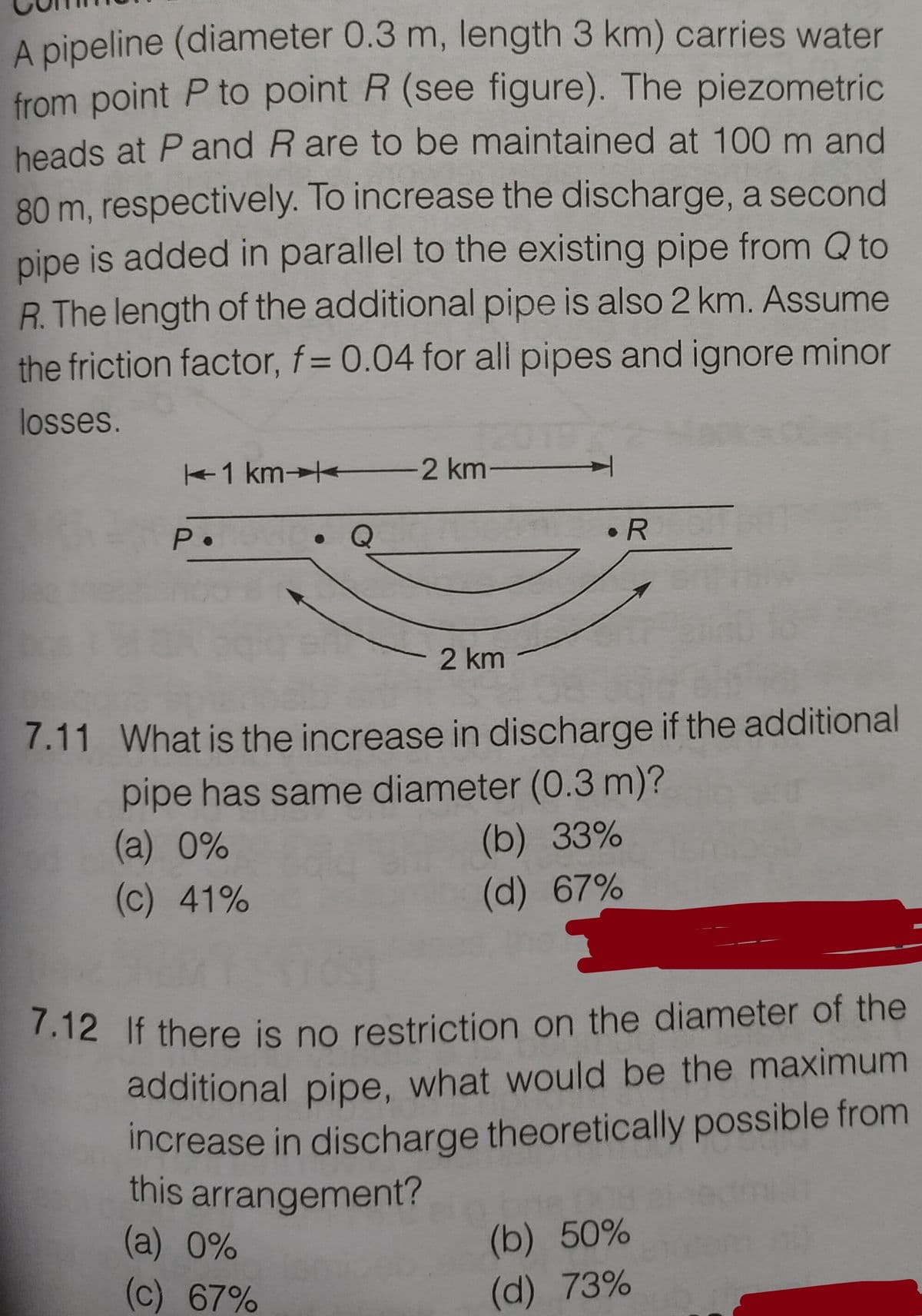7.12 If there is no restriction on the diameter of the A pipeline (diameter 0.3 m, length 3 km) carries water from point P to point R (see figure). The piezometric heads at P and R are to be maintained at 100 m and 80 m, respectively. To increase the discharge, a second pipe is added in parallel to the existing pipe from Q to R. The length of the additional pipe is also 2 km. Assume the friction factor, f= 0.04 for all pipes and ignore minor losses. 1 km- 2 km- P• .R 2 km 7.11 What is the increase in discharge if the additional pipe has same diameter (0.3 m)? (a) 0% (c) 41% (b) 33% (d) 67% 112 If there is no restriction on the diameter of the additional pipe, what would be the maximum increase in discharge theoretically possible from this arrangement? (a) 0% (b) 50% (d)73% (c) 67%
7.12 If there is no restriction on the diameter of the A pipeline (diameter 0.3 m, length 3 km) carries water from point P to point R (see figure). The piezometric heads at P and R are to be maintained at 100 m and 80 m, respectively. To increase the discharge, a second pipe is added in parallel to the existing pipe from Q to R. The length of the additional pipe is also 2 km. Assume the friction factor, f= 0.04 for all pipes and ignore minor losses. 1 km- 2 km- P• .R 2 km 7.11 What is the increase in discharge if the additional pipe has same diameter (0.3 m)? (a) 0% (c) 41% (b) 33% (d) 67% 112 If there is no restriction on the diameter of the additional pipe, what would be the maximum increase in discharge theoretically possible from this arrangement? (a) 0% (b) 50% (d)73% (c) 67%
Chapter2: Loads On Structures
Section: Chapter Questions
Problem 1P
Related questions
Question
i need solution in 5 min

Transcribed Image Text:7.12 If there is no restriction on the diameter of the
A pipeline (diameter 0.3 m, length 3 km) carries water
from point P to point R (see figure). The piezometric
heads at P and R are to be maintained at 100 m and
80 m, respectively. To increase the discharge, a second
pipe is added in parallel to the existing pipe from Q to
R. The length of the additional pipe is also 2 km. Assume
the friction factor, f= 0.04 for all pipes and ignore minor
losses.
1 km→ 2 km
P•
• R
2 km
7.11 What is the increase in discharge if the additional
pipe has same diameter (0.3 m)?
(a) 0%
(c) 41%
(b) 33%
(d) 67%
7.12 If there is no restriction on the diameter of the
additional pipe, what would be the maximum
increase in discharge theoretically possible from
this arrangement?
(a) 0%
(c) 67%
(b) 50%
(d) 73%
Expert Solution
This question has been solved!
Explore an expertly crafted, step-by-step solution for a thorough understanding of key concepts.
Step by step
Solved in 2 steps with 3 images

Knowledge Booster
Learn more about
Need a deep-dive on the concept behind this application? Look no further. Learn more about this topic, civil-engineering and related others by exploring similar questions and additional content below.Recommended textbooks for you


Structural Analysis (10th Edition)
Civil Engineering
ISBN:
9780134610672
Author:
Russell C. Hibbeler
Publisher:
PEARSON

Principles of Foundation Engineering (MindTap Cou…
Civil Engineering
ISBN:
9781337705028
Author:
Braja M. Das, Nagaratnam Sivakugan
Publisher:
Cengage Learning


Structural Analysis (10th Edition)
Civil Engineering
ISBN:
9780134610672
Author:
Russell C. Hibbeler
Publisher:
PEARSON

Principles of Foundation Engineering (MindTap Cou…
Civil Engineering
ISBN:
9781337705028
Author:
Braja M. Das, Nagaratnam Sivakugan
Publisher:
Cengage Learning

Fundamentals of Structural Analysis
Civil Engineering
ISBN:
9780073398006
Author:
Kenneth M. Leet Emeritus, Chia-Ming Uang, Joel Lanning
Publisher:
McGraw-Hill Education


Traffic and Highway Engineering
Civil Engineering
ISBN:
9781305156241
Author:
Garber, Nicholas J.
Publisher:
Cengage Learning